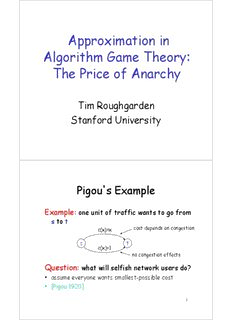
Approximation in Algorithm Game Theory: The Price of Anarchy PDF
Preview Approximation in Algorithm Game Theory: The Price of Anarchy
Approximation in Algorithm Game Theory: The Price of Anarchy Tim Roughgarden Stanford University Pigou's Example Example: one unit of traffic wants to go from s to t cost depends on congestion c(x)=x s t c(x)=1 no congestion effects Question: what will selfish network users do? • assume everyone wants smallest-possible cost • [Pigou 1920] 2 Motivating Example Claim: all traffic will take the top link. c(x)=x Flow = 1-Є s t c(x)=1 this flow is envious! Flow = Є Reason: ⇒ • Є > 0 traffic on bottom is envious ⇒ • Є = 0 equilibrium – all traffic incurs one unit of cost 3 Can We Do Better? Consider instead: traffic split equally c(x)=x Flow = ½ s t c(x)=1 Flow = ½ Improvement: • half of traffic has cost 1 (same as before) • half of traffic has cost ½ (much improved!) 4 Braess’s Paradox Initial Network: ½ ½ x 1 s t ½ ½ 1 x Cost = 1.5 5 Braess’s Paradox Initial Network: Augmented Network: ½ ½ ½ ½ x 1 x 1 s t s 0 t ½ ½ ½ ½ 1 x 1 x Cost = 1.5 Now what? 6 Braess’s Paradox Initial Network: Augmented Network: ½ ½ x x 1 1 s t s 0 t ½ ½ 1 x 1 x Cost = 1.5 Cost = 2 7 Braess’s Paradox Initial Network: Augmented Network: ½ ½ x x 1 1 s t s 0 t ½ ½ 1 x 1 x Cost = 1.5 Cost = 2 All traffic incurs more cost! [Braess 68] • also has physical analogs [Cohen/Horowitz 91] 8 High-Level Overview Motivation: equilibria of noncooperative network games typically inefficient • e.g., Pigou's example + Braess's Paradox • don't optimize natural objective functions Price of anarchy: quantify inefficiency w.r.t some objective function Our goal: when is the price of anarchy small? – when does competition approximate cooperation? – benefit of centralized control is small 9 Nonatomic Selfish Routing ½ x x s t s t 1 1 ½ 10 Our Objective Function Definition of social cost: total cost C(f) incurred by the traffic in a flow f. Formally: if c (f) = sum of costs of P edges of P (w.r.t. flow f), then: s t ΣΣΣΣ C(f) = f • c (f) P P P 11 Our Objective Function Definition of social cost: total cost C(f) incurred by the traffic in a flow f. Formally: if c (f) = sum of costs of P edges of P (w.r.t. flow f), then: s t ΣΣΣΣ C(f) = f • c (f) P P P Example: x ½ s t Cost = ½•½ +½•1 = ¾ ½ 1 12 The Price of Anarchy Defn: price of obj fn value of worst equilibrium anarchy = optimal obj fn value of a game – definition from [Koutsoupias/Papadimitriou 99] Example: POA = 4/3 in Pigou's example ½ 1 x x s t s t 1 1 ½ Cost = 3/4 Cost = 1 13 A Nonlinear Pigou Network Bad Example: (d large) xd 1 1-Є s t 1 0 Є ≈ equilibrium has cost 1, min cost 0 14 A Nonlinear Pigou Network Bad Example: (d large) xd 1 1-Є s t 1 0 Є ≈ equilibrium has cost 1, min cost 0 ⇒⇒⇒⇒ price of anarchy unbounded as d -> infinity Goal: weakest-possible conditions under which P.O.A. is small. 15 When Is the Price of Anarchy Bounded? Examples so far: x xd x 1 s 0 t s t s t 1 1 1 x Hope: imposing additional structure on the cost functions helps – worry: bad things happen in larger networks 16 Polynomial Cost Functions Def: linear cost fn is of form c (x)=a x+b e e e Theorem: [Roughgarden/Tardos 00] for every network with linear cost functions: cost of cost of x ≤ 4/3 × s t Nash flow opt flow 1 17 Polynomial Cost Functions Def: linear cost fn is of form c (x)=a x+b e e e Theorem: [Roughgarden/Tardos 00] for every network with linear cost functions: cost of cost of x ≤ 4/3 × s t Nash flow opt flow 1 Bounded-deg polys: (w/nonneg coeffs) replace 4/3 by ≈ d/ln d xd tight s t example 1 18 A General Theorem Thm: [Roughgarden 02], [Correa/Schulz/Stier Moses 03] fix any set of cost fns. Then, a Pigou-like example 2 nodes, 2 links, 1 link w/constant cost fn) achieves worst POA xd tight s t example 1 19 Pigou Bound Recall goal: want to show Pigou-like examples are always worst cases. Pigou bound: given set of cost functions (e.g., degree-d polys), largest POA in a network: • two nodes, two links xd • one function in given set s t 1 • one constant function – constant = cost of fully congested top edge 20
Description: